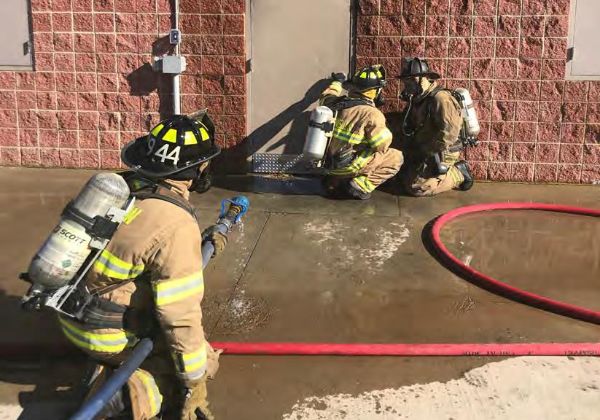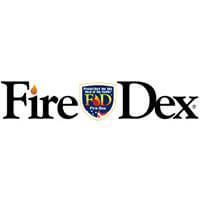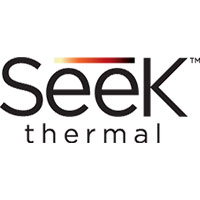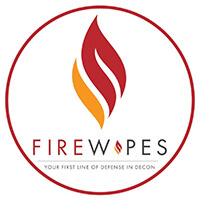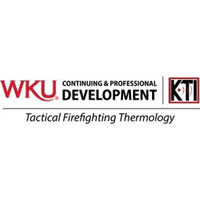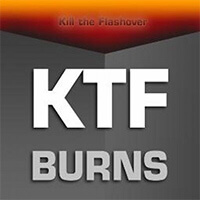The following proposal is a customized 32-hour course that will be delivered to host organization. This program will consist of 16 hours of classroom customized to the host organizations specific brand(s) of thermal imaging camera. The classroom portions will be followed by 16 hours of live fire hands-on training. This program will include:
- A custom student manual (printed by the host organization) covering the course material in-depth.
- An SOG Template to assist the department with adding thermal imaging to their standard operating practices.
- Lesson Plans for their training staff to use and assist with training their department.
- Access to a custom drop box resource folder for the host organization that offers videos, Power Points, and numerous resources to further their thermal imaging training.
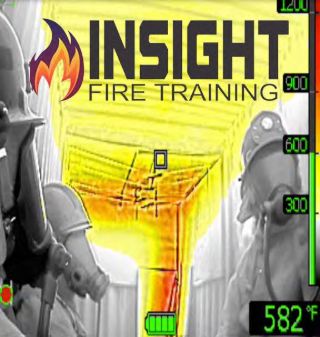
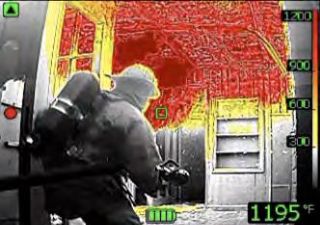
Day 1-Introduction to Tactical Thermal Imaging:
The day begins with a 4-hour classroom followed by 4 hours of live fire demonstrations that include the Introduction to Tactical Thermal Imaging Program and Enhancing Strategies & Tactics program. These demonstrations will consist of:
- Proper image interpretation: Understanding what we see! The following concepts will be covered-Reading the heat, identifying thermal layer, locating the fire, determining fire severity, and preventing thermal insult.
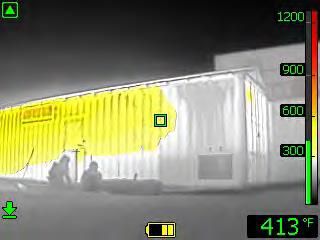
- Field of View (F.O.V): Understanding how the TIC diminishes our field of view and how to overcome this problem. Each student will see the difference in changing their F.O.V. and how this can benefit their tactics (standard grip versus horizontal, too close/too far). Students will observe the difference in a wider field of view. They will be shown how to properly scan a room and use each TIC comparatively to make a fair assessment. This prevents firefighters from tunnel vision and missing valuable thermal information.
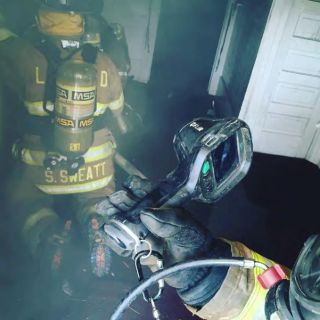
- Understanding Temperature Modes: Each Student will perform a scan with their respective Thermal Imaging Camera and notice the difference from High Sensitivity to Low Sensitivity. A target of over 300 degrees will be needed for this scenario. Students will observe the difference in detail that High Sensitivity makes in discernable details such as identifying victims, downed firefighters, and egress points. Each TIC will be viewed and compared to see which produces a better and more discernable image in high sensitivity and low sensitivity. Students will become intimately familiar with the color/temperature correlations of their specific model/brand of Thermal Imaging Camera. This drill will enhance the student’s situational awareness of the actual thermal conditions around them that are often hidden due to limited or zero visibility conditions.
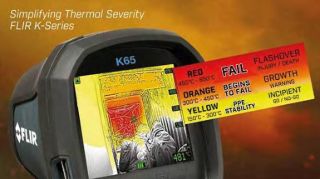
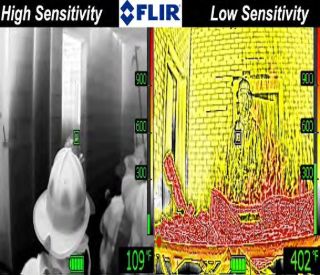
Photo courtesy of Insight Training LLC and FLIR copyright 2018
- Resolution-Equating High Resolution to Higher Levels of Success: The students will scan the fire environment at three preset distances and note the difference in the resolution in their respective TIC’s and how this can affect their decision-making process. A victim, adult or child mannequin, or downed firefighter will be placed within their field of view. The ability to see the victim at preset distances will show the effective range of the TIC and the value of high resolution versus low resolution. when firefighters can stand at varying distances from the target and compare the heat signatures that are seen and NOT see by certain TIC’s. This will emphasize the importance of understanding the TIC’s effective resolution success ratio along with its Distance to Spot Ratio.
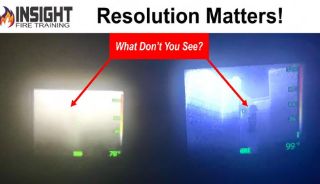
- Thermal Sensitivity: Learning how to maximize the TIC’s ability to see important details such as: victims & downed firefighters, room configuration, holes in floors, and locating secondary means of egress. As the students exit the structure or container and then they will be grouped together to see the difference in the MRTD of their TIC and learn the danger of uniform temperature environments. This demonstration will show how a firefighter can easily blend in with their environment. They will watch an instructor stand back in the corner and see how they blend in. They will watch the difference in superheated gear versus the contrast in the SCBA cylinder, the air hose, and the regulator line. This is one of the most undervalued and overlooked attributes of a thermal imaging camera. If the TIC has too high of a thermal sensitivity, the firefighters will likely miss a victim that can easily blend in with the surrounding temperatures as shown also in the photo below.
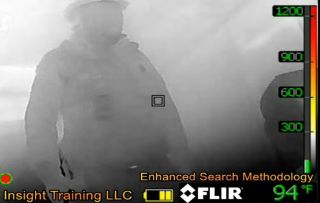
- Understanding TIC limitations: This is known as the emissivity and reflection demonstrations. Learning how to differentiate between a reflection and a true heat source. A shiny metal object will be placed in close proximity of the fire room and the students will be shown how to interpret the image and differentiate from a reflection and a true heat source. (glass door, stainless fridge, shiny floors etc.). As they move toward the target the reflection will move (angle in or angle out) where a true heat source will not. As shown in this image with the Max Fire Box, firefighters can also clearly see that the spot temperature (or DTM) is not accurate due to the reflective surface of the diamond plating. Some recommendations for this drill include having a framed window stand in the smoke environment and allowing a firefighter to go behind it show that the TIC cannot “see” through low emissivity glass.
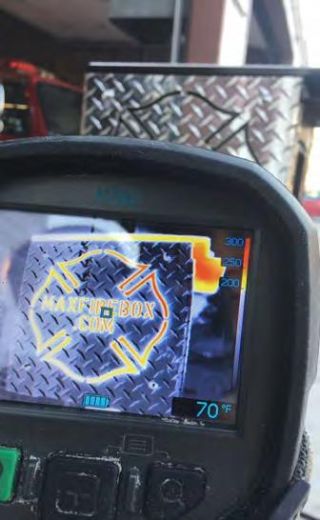
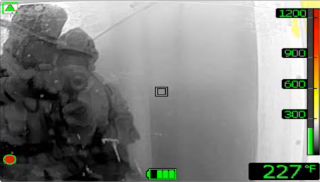
Day 2- Fire Ground Application:
The day begins with a 4-hour classroom session covering fire ground applications of the following concepts: Tactical 360, Go/No Go Decision Making, and Enhanced Stream Placement evolutions to aid in their understanding, and interpretation, and to increase their confidence with their TIC. The afternoon will consist of 4 hours of live fire training completing the objectives they have just learned in the classroom. Students will be guided through stations where they are allowed to take their time and fully understand each concept.
- Tactical 360
- Go/No Go Decision Making
- Enhanced Stream Placement
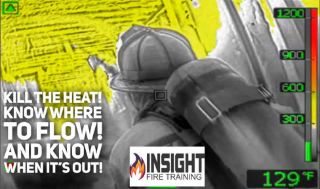
Day 3- Enhanced Search Methodology:
The day will begin with a 4-hour classroom on Enhanced Search Methodology & RIC efforts. After the classroom session is completed Students will be grouped into teams and complete various search scenarios such as:
- TIC directed Search: The students will be guided through scenarios where they learn to stay oriented, the crew leader assesses, guides, and communicates information to the search members, and they learn how to use the TIC to locate secondary means of egress.
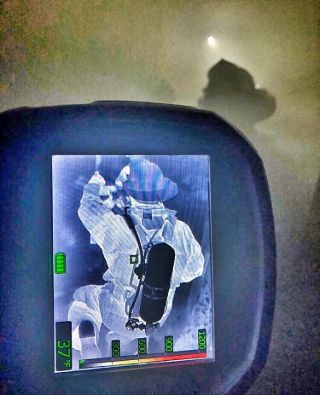
- Simultaneous Fire Attack & Search: This model is the most realistic search evolution in the American fire service. The majority of America responds with less than 10 firefighters to a fire on average. Therefore, the first due crew’s efforts are critical in regard to rescue and fire suppression. This evolution demonstrates how a reduced staffing crew equipped with a situational awareness TIC on the nozzleman and a decision-making TIC on the crew leader allows for simultaneous fire attack and search while moving to the seat of the fire.
- VEIS: VEIS is a standard concept in rescue but when tactical thermal imaging is implemented it becomes a game-changer! Students learn and reinforce basic VEIS concepts such as ladder placement when to take glass and door control. With Tactical TIC usage they are able to implement faster more efficient search methods, close and search beyond the door if necessary, and crew leaders are able to monitor the conditions of the search member serving as an extra level of accountability.
- Rapid Intervention Scenarios: Firefighters are lost each year in structure fires for a variety of reasons. However, there remains a common thread for many of these incidents. Firefighters become lost or disoriented and fail to recognize thermally severe environments until it’s too late. With the implementation of Tactical TIC methods, rapid intervention efforts are faster, more efficient, and reduce the amount of time needed to locate and remove the downed firefighter.
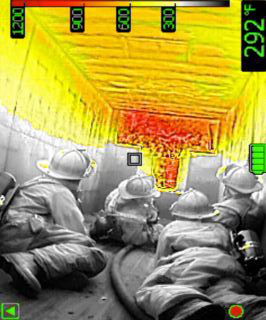
Day 4 Implementation Procedures:
This will be a full day of live fire hands-on training beginning with the students receiving a one-hour briefing on the day’s schedule and objectives. Students will be grouped into teams and function as they would on the fire ground under the supervision of an Insight Training Instructor. They will complete the following: Tactical 360, Go/No Go Decision Making, Enhanced Stream Placement (Locating &. Fully extinguishing the fire), Search Scenario, and RIC scenario. Scenarios will be developed ahead of time through planning with the training staff to match the types of buildings and scenarios they regularly face in their response areas.
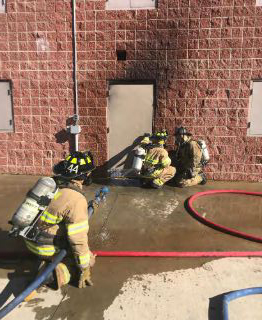
This course requires 3-4 instructors (dependent upon total number of students and is available starting at $12,000-$20000. Price Breakdown for your reference will be:
- $12,000 for 2 Instructors for up to 10 students
- $14,000 for 3 Instructors for up to 15 students
- $16,000 for 4 Instructors for up to 20 students
- $18,000 for 5 Instructors for up to 25 students.

This program and course offerings are labor and planning-intensive. We have assisted several departments internationally with this training and our pre-planning ranged from 1-3 months depending upon their needs and level of training that was required. We will need advanced notice as soon as possible to begin properly planning for this event. Our instructors will need a total of 6 days off to do this event consisting of one travel day, four work days, and one travel day to return home.
Please let us know if you have any questions or concerns as this program is completely customized to your needs and specific requests. Thanks again for choosing Insight Training LLC as your thermal imaging training provider.
Andrew J. Starnes
Level II Thermography Certified
Insight Training LLC
www.insighttrainingllc.com
